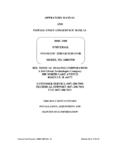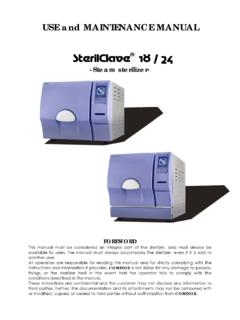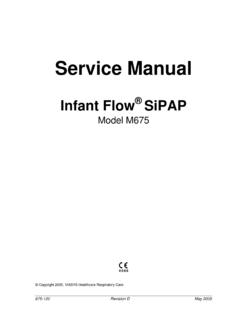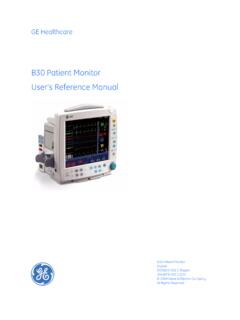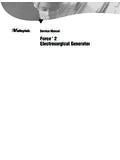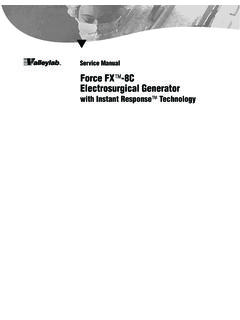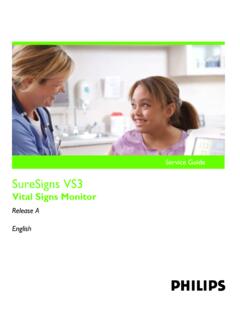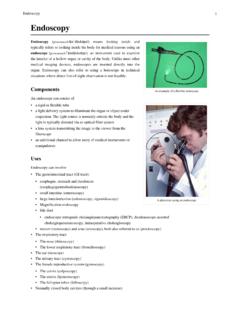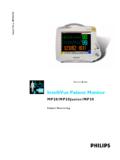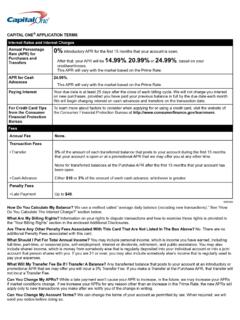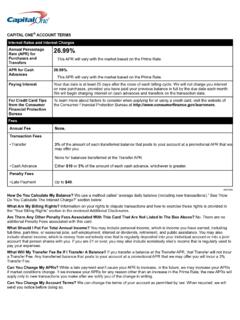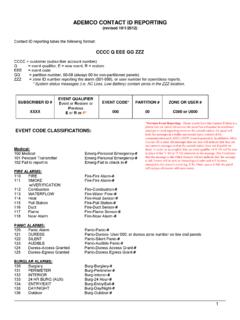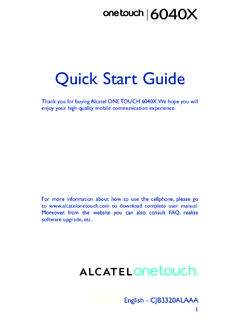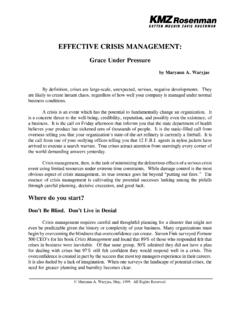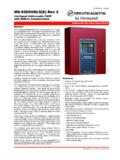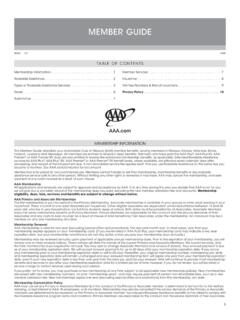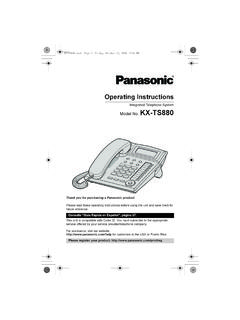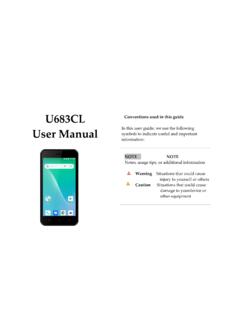Transcription of List of instruments used in ophthalmology
1 List of instruments used in ophthalmology1 List of instruments used in ophthalmologyInstruments used specially in ophthalmology are as follows: [1]__Forcetoc__Instrument list Instrument Uses Spectacles (glasses)to correct refractive errors of the eye; not invasiveContact lensesto correct refractive errors of the eye; a little invasivePhoropterused in refraction testingTonometersused to determine the intraoccular pressure (IOP) - useful in glaucoma; vide link for various types :to keep the eyes open during any operationUniversal eye speculum-do-; heavy instrument and can not keep eyelashes out of the operating field Guarded eye speculum (left andright)-do-; heavy instrument but can keep eyelashes out of the operating field with its "guard" and hence left or rightones are required Wire Speculumto keep the eyes open during any operation; light wire instrumentNeedle holders:holding the needle in position while applying sutures Silcock's needle holder-do-; has a catch and is used for heavier gauge needles; used mainly for skin, muscle and corneal incisions Arruga's needle holder-do-; has a catch (lock) and is used for heavier gauge needles (thicker than 6-0); used mainly for skin, muscleand corneal incisions Barraquer's needle holder-do-; small instrument with a spring action with or without a catch used for finer gauge needles (5-0 or finer).
2 Used mainly for intraoccular [2] incisionsForceps:to hold anything Artery forceps (haemostat)medium sized, with a serrated tip and a catch; used to hold bleeding vessels and compress them in order tomake them stop bleeding and also to hold or crush structures. Fixation forcepshas a few teeth at the tip; for holding structures and restricting their movement or to hold small swabs Plain dissecting forcepsblunt untoothed with a serrated tip; for holding structures and restricting their movement or to hold smallswabs Iris forcepsfine tipped (straight or otherwise) with small teeth; to hold the iris tissue during procedures Elschnig's intracapsular forcepsfine untoothed forceps for holding tissue, swabs, sutures, etc.; removing things like clots, capsule fragments,lens, etc.; used in cataract surgery Arruga's intracapsular forcepsfine untoothed forceps holding tissue, swabs, sutures, etc.
3 ; removing things like clots, capsule fragments, lens,etc.; used in cataract surgery Colibri forcepsfine toothed forceps for holding flaps of cornea or sclera and rarely the iris Saint Martin's forcepsholding flaps of cornea or sclera and rarely the iris Superior rectus holding forcepsspecially curved (to fit into the orbit of the eye) forceps for catching hold of the muscle bellies of theintraorbital muscles and sutures Suture tier forcepsfine limbed untoothed forceps to hold fine sutures or hairs Capsulotomy forcepsto tear the anterior capsule of the lens during cataract surgery Disc holding forcepsused in glaucoma surgery (obsolete)List of instruments used in ophthalmology2 Capsulorhexis forcepsfine sharp-tipped untoothed forceps for doing a continuous curvilinear incision and removal of the anteriorcapsule of the lens ("continuous curvilinear capsulorhexis - ccc")
4 MacPherson's forcepsfine sharp-tipped untoothed forceps with an angulation for holding parts of the lens, the intraocular lens, 10-0(very fine) sutures, etc. Chalazion forceps (clamp)self-retaining with discoid ends; used to hold and prevent a chalazion from bleeding during its surgery Epilation forceps (Cilia forceps)stout flat-ended blunt forceps with a thickened end to remove eyelashes Entropion forcepsself-retaining with big discoid ends used to hold and prevent an entropion from bleeding during its surgeryChalazion scoopto remove the granulation tissue from a chalazion during surgeryEntropion clampright and left varieties exist; large clamp with two limbs; self-retaining with big discoid ends used to hold andprevent an entropion from bleeding during its surgeryNettleship's punctum dilatorto dilate the lacrimal punctum of the lacrimal apparatus of the eye for syringing or operationsCystitomea 26 gauge needle bent twice used for incising the anterior capsule of the lens in lens extractionWire vectisa loop of wire attached to a stack used to extract cataract affected lensesIrrigating vectisa small hollow instrument with a used to introduce fluid into the anterior chamber to raise its pressure to aidcataract extraction [3]Canulaused to carry fluid Irrigation-aspiration two-waycanulaeffectively two small canulae fitted together, one to introduce fluid and the other to extract the corticalmaterials, blood, etc.
5 In eye operations Lacrimal canulasmall curved canula the size of a syringe needle used to introduce fluids or drugs into the nasolacrimal passageto test its patency or during surgery (dacrocystography, dacrocystectomy, dacryocystorhinostomy(DCR), 's lacrimal dissector withscoopfor blunt dissections and cleaning during operations like dacryocystorhinostomyRouginedissection of lacrimal sacRetractorto pull and hold overlying tissue out of the operating field Muller's self retaining adjustablehaemostatic retractor-do-; self retaining haemostatic Cat's paw retractor-do- Desmarre's lid retractor-do-; specially for noncooperative patients and to see the fornices (see human eye)Bone punchto fracture pieces from a thin bone in facial surgery and during operations like dacryocystorhinostomyEvisceration spoon or scoopremoving all the contents of the eyeball during evisceration (complete removal of all structures within the eyein diseases like endophthalmitisLid plateflat large instrument that has a groove and is placed between the lid and globe of the eye to provide a solidsupport for eyelid surgeryHammer, chisel and bone gougebone cutting and shapingBowmen's discission needlemicrosurgery of the lens capsule[4]Knivesto cut structures Surgical scalpel with small bladesgeneral purpose instrument von Graefe's cataract knifecutting out of the anterior chamber from the inside through the limbus Tookes' knife (Sclero-cornealsplitter)))
6 Making sclerocorneal tunnels in "small incision cataract surgery (SICS)" and keratoplasty Crescent knife (Sclero-cornealsplitter)making sclerocorneal tunnels in "small incision cataract surgery"List of instruments used in ophthalmology3 Angular keratomemaking sclerocorneal tunnels in "small incision cataract surgery"; larger one used to increase the size of theincision Side-port blademaking sclerocorneal "side port" (a secondary tunnel) tunnels in "small incision cataract surgery" Beer's knifeincise the conjunctiva or the eyelid skin Keratotomesmall triangular blade with two sharp edges used to incise the limbus (sclerocorneal junction) Zeigler's knifevery tiny knife for intaoccular maneuvers specially when space is lessScissors- Conjunctival sac scissorsflat small curved scissors to cut the conjunctive Corneal spring scissorsmedium spring-open used to cut the external side of the cornea, fine sutures; iris, etc.
7 De' Wecker's iris scissorssmall slender spring-open scissors for intraoccular maneuvers (iris and deeper and more delicate structures);has two wings to operate it and one sharp and one blunt blade. Vannas' scissorssmall slender spring-open scissors for intraoccular maneuvers (iris and deeper and more delicate structures);has two wings to operate it and one sharp and one blunt blade. Enucleation scissorsthick scissors used to cut the optic nerve in enucleation operationBowman's lacrimal probeprobing the nasolacrimal ductLens expressorused to force out the lens in extracapsular or intracapsular cataract extractionMcNamar's spoonused to force out the lens in intracapsular cataract extractionIris repositortwo limbed instrument used to remove the iris during posterior chamber maneuversSinsky's hook intraocular lensdiallerangulated round hook with a handle used in insertion of an intraocular lensStrabismus hookmuscle hook or squint hook; sharp tip or knobbed tip.
8 Used in squint surgeryForeign body spud and needleSpud to remove superficial and needle for the deep foreign bodies in the eyeElliot's trephine with handleused in corneal donation (eye donation) to cut out the cornea in a circular fashionCastroveijo's calipersvarious measurements are takenCastroveijo's corneal trephineused in corneal donation (eye donation) to cut out the cornea in a circular fashionPin-holetesting visual acuityRed green goggles(red - right side & green - left side) used in Worth 4 dot test, diplopia testingPrismsto diagnose squints; in other instruments ; refractive correction; 's discto assess the condition of the corneal surfaceRetinoscopeobjective determination of refractive error and for looking inside the eyeLoupeused ot search for magnified examination of the anterior segment of the eye (uniocular or binocular)Jackson's cross cylinderused to check the power and axis of a cylindrical lensMaddox rodused to test for latent squint and retinal functionRefraction boxhas lenses of different powers for refraction testingSlit lamp bimicroscopeused for examining the anteriorly placed structures the eye; vide linkCharts for vision- Distant visionto determine visual acuity of distant vision Snellen's distant vision chart-do-; for those who can read in English Regional language charts-do-; for those who can read in their local language E Chart-do.
9 For those who can not read Landolt's broken ring chart-do-; for those who can not readList of instruments used in ophthalmology4 Toys pr picture chart-do-; for children Near vision-do-; to determine visual acuity of near vision Jager's chart-do- Printer's types of N series-do- Snellen's near chart (1/17threduction of distant chart)-do-; standard chart of alphabets; vide link Colour vision:to test colour vision Ishihara's chartto determine the type of colour blondnessStenopaeic slitdetection of axis of the cylindrical (astigmatism) power of the eye; glaucoma testingImplants- Intraocular lensprosthetic lenses implanted after lens (anatomy) removal Artificial eyesas non-functional cosmetic implants into the eye socketBlade breakerto break disposable blade after use to prevent reuseThermo-cauteryto coagulate blood vessels and prevent haemorrhageCryoprobeto freeze and extract the lensYttrium aluminium garnet laser(YAG laser)to correct posterior capsular opacification (specially after removal of a cataract, if required), peripheraliridotomy, retinal surgery, laser-assisted sub-epithelial keratectomy (LASEK)[5] for permanent hair removalElectrocauteryfor electrosurgeryPhacoemulsificationused for extraction of a cataract affected lens after emulsifying it using a high frequency (energy)
10 Ultrasoundprobe [6]Image galleryGlassesContact lensesPlain dissecting forcepsArtery forceps orHaemostatMosquito forcepsLinen holding forcepsBowman's lacrimal probeSaint Martin's forcepsList of instruments used in ophthalmology5 Eye Lens expressorNettleship's punctum dilatorSmall scissorsScalpel with bl;age attachedConjunctival sac scissorsBarraquer's needle holderLacrimal sac dilator with scoopMuller's retractor, top viewMuller's retractor,bottom viewAngular keratotomeLong dissecting forcepsUniversal eye speculumRougineIris repositorIrrigating vectisLacrimal dissector withscoopSpecial bladesvon Graefe's cataract knifeForeign body spud and needleCystitomeAngular keratotomesBarraquer's needle holderA bone punchCallipersList of instruments used in ophthalmology6 Corneal spring scissorsIntraoccularlenses in theircasesIntraoccular lens in placeIntraoccular lens " dialer "or Sinsky hookIrrigating aspirating bi-waycannulaLenses used for refraction testingA retinoscopeSuture tying forceps for finesutures like 8-0 Upper one: Suture tying forceps;Lower one: Iris forceps; ForcomparisonUpper right: Corneal springscissors.
